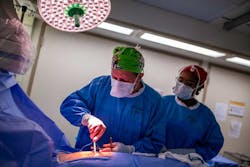A new Canadian study reports an alternative way to connect leads to cardiac defibrillators.
Leads are special connectors or wires that deliver energy from an implantable cardioverter defibrillator (ICD) to the heart. Placing an ICD involves placing a wire through a vein, into the chest and into the heart.
The ICD study, conducted by researchers at Population Health Research Institute (PHRI), has demonstrated that a new type of cardiac defibrillator called a subcutaneous (S-ICD) reduced patient complications by more than 90 %, compared to traditional defibrillator, called a transvenous ICD (TV-ICD).
The S-ICD, explained the researchers, is implanted under the skin just below the patient’s armpit. The S-ICD lead runs under the skin, alongside the breastbone. The procedure eliminates the need to place leads into the heart or blood vessels.
“The S-ICD greatly reduces perioperative, lead-related complications without significantly compromising ICD performance,” said Jeff Healey, a senior scientist at PHRI, a research institute of McMaster University and Hamilton Health Sciences (HHS).
The S-ICD is an “attractive alternative” to the TV-ICD, particularly in patients at increased risk for lead-related complications.
That’s partly because a drawback of the procedure is that leads are the least reliable component of a traditional defibrillator. They can cause complications such as perforations in the heart muscle or lungs and blood clotting in veins, according to Healey, a professor of cardiology at McMaster as well as an electrophysiologist at HHS.
Healey also noted they may contribute to premature revision of the system in up to 20% of patients during the typical lifespan of an ICD generator.
The study involved 544 electrocardiographically screened patients; 251 were randomized to receive the S-ICD (a Boston Scientific Emblem device), and 252 patients received a TV-ICD.
Patients were followed up for an average of 2.5 years to this point and follow-up is ongoing for the study.
Findings of the trial, Avoid Transvenous Leads in Appropriate Subjects (ATLAS) S-ICD, were presented at Heart Rhythm 2022 in San Francisco on April 30.
About the Author

Rehana Begg
Editor-in-Chief, Machine Design
As Machine Design’s content lead, Rehana Begg is tasked with elevating the voice of the design and multi-disciplinary engineer in the face of digital transformation and engineering innovation. Begg has more than 24 years of editorial experience and has spent the past decade in the trenches of industrial manufacturing, focusing on new technologies, manufacturing innovation and business. Her B2B career has taken her from corporate boardrooms to plant floors and underground mining stopes, covering everything from automation & IIoT, robotics, mechanical design and additive manufacturing to plant operations, maintenance, reliability and continuous improvement. Begg holds an MBA, a Master of Journalism degree, and a BA (Hons.) in Political Science. She is committed to lifelong learning and feeds her passion for innovation in publishing, transparent science and clear communication by attending relevant conferences and seminars/workshops.
Follow Rehana Begg via the following social media handles:
X: @rehanabegg
LinkedIn: @rehanabegg and @MachineDesign

